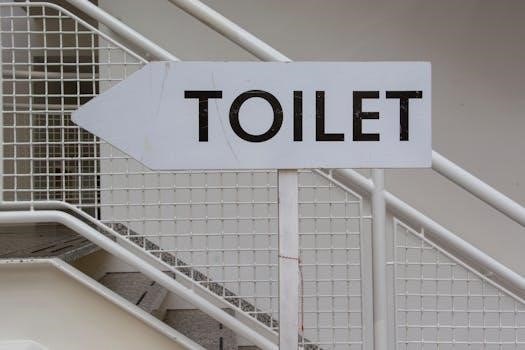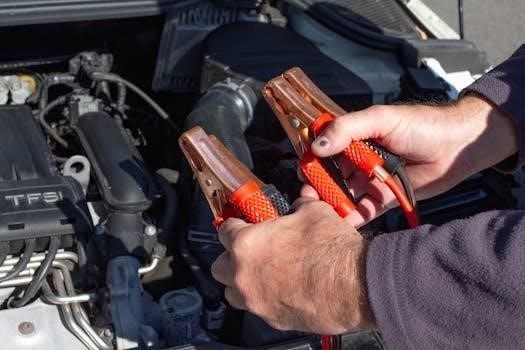
AMP Research Power Step Troubleshooting Guide⁚ A Comprehensive Approach
Welcome to a comprehensive guide designed to help you navigate the complexities of troubleshooting your AMP Research Power Step system. This resource aims to provide clear‚ concise steps for diagnosing and resolving common issues. With this guide‚ you’ll be able to restore functionality!
Understanding the AMP Research Power Step System
The AMP Research Power Step system is an innovative accessory designed to enhance vehicle accessibility. It operates by automatically extending when the door opens and retracting when the door closes. This functionality relies on a complex interaction between electrical and mechanical components‚ making understanding the system crucial for effective troubleshooting.
At its core‚ the system uses a motor to drive linkages that deploy and retract the steps. These linkages must be free of obstructions and properly lubricated for smooth operation. The system also includes sensors and wiring harnesses that transmit signals from the vehicle’s doors to the control module.
The control module interprets these signals and activates the motor accordingly. A malfunction in any of these components can lead to issues‚ requiring systematic troubleshooting to identify the root cause. Familiarizing yourself with these basics is the first step in resolving Power Step problems efficiently.
Understanding the system’s reliance on electrical and mechanical components is the foundation for effectively diagnosing any potential issues that may arise over time with use.
Identifying Your Power Step Model
Before initiating any troubleshooting steps‚ it’s essential to accurately identify your specific AMP Research Power Step model. Different models may have variations in wiring‚ components‚ and installation procedures‚ which can affect the troubleshooting process. Locating the model number is the first crucial step.
Typically‚ the model number can be found on a sticker affixed to the control module or on the step assembly itself. This sticker often includes other relevant information‚ such as the manufacturing date and serial number. Make a note of this information for future reference.
If you’re unable to locate the sticker‚ consult your original purchase documentation or the vehicle’s paperwork‚ as the model number may be listed there. With the correct model identification‚ you can access specific technical documents and resources that are tailored to your particular Power Step system.
This ensures that you are using the correct troubleshooting steps and replacement parts‚ saving time and preventing further complications. Accurate identification will streamline the troubleshooting process significantly‚ leading to faster and more effective repairs.
Key Components and Their Functions
Understanding the key components of your AMP Research Power Step system and their respective functions is crucial for effective troubleshooting. The system consists of several interconnected parts‚ each playing a vital role in the operation of the power steps. Familiarizing yourself with these components will help you diagnose issues more accurately.
The primary components include the control module‚ which acts as the brain of the system‚ receiving signals and controlling the steps’ movement. The motor and actuator are responsible for the physical deployment and retraction of the steps.
Wiring harnesses connect all components‚ transmitting power and signals. The door sensors detect when a door is opened or closed‚ signaling the control module to activate the steps. Linkages and pivot points allow the steps to move smoothly.
Fuses protect the system from electrical overloads. An override switch‚ if equipped‚ allows manual control of the steps. Understanding the function of each component enables you to pinpoint the source of a problem. For example‚ if the steps don’t move‚ the issue could be the motor‚ actuator‚ or a wiring problem. Knowing this allows more targeted and efficient troubleshooting.

Common PowerStep Problems⁚ A Quick Checklist
Before diving into detailed troubleshooting‚ start with a quick checklist of common problems that can affect your AMP Research Power Step system. This will help you quickly identify and resolve simple issues‚ saving you time and effort. First‚ check the power source⁚ ensure the system is receiving power by verifying the fuse is intact and the wiring connections are secure.
Next‚ inspect the steps for any physical obstructions that might be preventing them from deploying or retracting properly. Look for ice‚ mud‚ or debris.
Test the door sensors to confirm they are signaling correctly when the doors open and close. If the steps are slow or jerky‚ examine the linkages for binding or seized points‚ lubricating them as needed.
Listen for unusual noises from the motor‚ which could indicate a malfunction. If equipped‚ check the override switch to ensure it is not inadvertently set to the “off” position. Finally‚ review the wiring for any signs of damage‚ corrosion‚ or loose connections. By systematically checking these common issues‚ you can often resolve the problem quickly.

Troubleshooting Step 1⁚ Power Issues
Begin by addressing the power supply. Ensure the AMP Research Power Step system receives adequate voltage. Check the fuse‚ wiring‚ and connections. A multimeter can help verify voltage. A stable power source is crucial for operation.
Checking the Power Source
Ensuring a stable and adequate power source is the first and most crucial step in troubleshooting any issues with your AMP Research Power Step system. Begin by visually inspecting the battery terminals for any signs of corrosion‚ which can impede electrical flow. Clean the terminals thoroughly using a wire brush and a solution of baking soda and water‚ then reattach securely.
Next‚ verify the battery voltage using a multimeter. A fully charged battery should read approximately 12.6 volts. If the voltage is significantly lower‚ the battery may be weak or failing and require replacement or charging.
Also‚ check the ground connections. Ensure that the ground wires are securely attached to a clean‚ unpainted metal surface on the vehicle’s frame. Loose or corroded ground connections can cause intermittent or complete power loss to the Power Step system.
Finally‚ test the power supply to the AMP Research controller directly. Use a multimeter to confirm that the controller is receiving the correct voltage as specified in the installation manual. If the voltage is low or absent‚ trace the wiring back to the battery‚ checking for any breaks or damage along the way.
Inspecting Fuses and Wiring
After verifying the power source‚ the next critical step in troubleshooting your AMP Research Power Step involves a meticulous inspection of the fuses and wiring. Locate the fuse associated with the Power Step system‚ typically found in the vehicle’s fuse box or within the Power Step wiring harness itself. Remove the fuse and visually inspect it for any signs of damage‚ such as a broken filament or blackened glass. If the fuse is blown‚ replace it with a new fuse of the exact same amperage rating.
Next‚ conduct a thorough examination of all wiring connected to the Power Step system. Look for any signs of wear‚ tear‚ or damage‚ such as frayed wires‚ exposed conductors‚ or corroded connectors. Pay close attention to areas where the wiring may be exposed to abrasion or extreme temperatures.
Check the wiring connections at the motor‚ controller‚ and door sensors‚ ensuring that they are secure and free from corrosion. Use a wire brush or electrical contact cleaner to remove any corrosion from the connectors.
If you find any damaged wiring‚ repair or replace it immediately. Use high-quality automotive-grade wiring and connectors to ensure a reliable and long-lasting repair.

Troubleshooting Step 2⁚ Motor and Actuator Problems
If the power supply is good‚ focus on the motor and actuator. These components are crucial for step movement. Identifying malfunctions here is the next key step in the process.
Identifying Motor Malfunctions
If your AMP Research Power Step fails to deploy or retract‚ the motor is often a primary suspect. Begin by listening closely when the door opens or closes; a faint humming or clicking sound might indicate the motor is receiving power but struggling to operate. No sound at all could point to a complete motor failure or an electrical supply issue‚ which should be verified with a multimeter as detailed in a later section.
Visually inspect the motor housing for any signs of physical damage‚ such as cracks or corrosion. Damage can impede its performance. If the motor shows external wear‚ consider whether debris or environmental factors might be contributing to the problem.
Disconnect the motor and test it independently with a direct power source. This bypasses the vehicle’s system and confirms whether the motor itself is functional. If it operates correctly when directly powered‚ the issue likely lies elsewhere‚ such as in the control module or wiring harness.
Examine the actuator arm connected to the motor. Ensure it moves freely and isn’t obstructed. Binding or stiffness in the actuator can overload the motor‚ preventing it from functioning correctly. Lubricate the joints to ensure smooth operation.
Step Binding or Seized Linkages
One of the most common culprits behind a malfunctioning AMP Research Power Step is binding or seized linkages. These linkages are critical for the smooth deployment and retraction of the step‚ and when they become obstructed‚ the entire system can grind to a halt. Start by visually inspecting all moving parts‚ looking for any signs of corrosion‚ debris accumulation‚ or physical damage.
Carefully clean the linkages with a wire brush to remove any rust or buildup. Apply a generous amount of penetrating lubricant to each joint and pivot point. Work the step manually‚ if possible‚ to help the lubricant seep into the affected areas. If the step remains stiff‚ consider disassembling the linkages for a more thorough cleaning and lubrication.
Check for any bent or damaged components that might be causing the binding. Replace these parts as needed‚ ensuring that all connections are secure and properly aligned during reassembly; Regularly lubricating these components will prevent future issues!
Door Signal Wiring Issues
The AMP Research Power Step relies on accurate door signal wiring to function correctly‚ deploying when a door opens and retracting when it closes. Issues with this wiring can lead to erratic behavior‚ such as the steps failing to deploy or retract‚ or even deploying at the wrong time. Begin by inspecting the connections to the door sensors and the Power Step controller.
Ensure all wires are securely connected and free from corrosion. Use a multimeter to test the continuity of the wires‚ checking for any breaks or shorts. If you find damaged wires‚ repair or replace them as needed. Verify that the door signal wires are properly connected to the correct terminals on the controller‚ referring to the wiring diagram provided with your Power Step system.
In some cases‚ the issue may stem from the door sensors themselves. Test the sensors to ensure they are functioning correctly. Replacing faulty sensors and securing the connections will help resolve this issue!
Override Switch Functionality and Troubleshooting
The override switch on your AMP Research Power Step offers manual control‚ allowing you to keep the steps deployed‚ retracted‚ or in automatic mode. If the override switch isn’t functioning correctly‚ it can lead to the steps not responding as expected. Begin by checking the switch itself. Ensure it’s properly connected to the controller and that the wiring is secure and free from damage.
Use a multimeter to test the switch’s continuity in each position‚ verifying that it’s sending the correct signals to the controller. If the switch is faulty‚ replace it with a new one. Also‚ check the controller’s settings to ensure the override function is enabled.
Sometimes‚ a loose connection or corroded terminal can cause the switch to malfunction. Clean the terminals and re-secure the connections. If the steps still don’t respond‚ consult the AMP Research troubleshooting guide for further assistance. Correctly functioning and properly installed override switches can solve this issue!

Troubleshooting with a Multimeter
A multimeter is essential for diagnosing electrical issues within your AMP Research Power Step system. Start by checking the power source. Ensure the system is receiving the correct voltage‚ typically 12V‚ by testing at the main power wire connection. Verify the ground connection is solid by measuring resistance between the ground wire and the vehicle’s chassis; it should be near zero ohms.
Next‚ test the fuses for continuity to ensure they are not blown. Check the wiring harness for any voltage drops‚ which could indicate damaged or corroded wires. Inspect the door trigger wires for proper signal voltage when the doors are opened and closed.
Use the multimeter to test the motor and actuator for proper operation. Measure the voltage at the motor terminals when the steps should be deploying or retracting. If there’s voltage but the motor isn’t working‚ the motor might be faulty and require replacement. A systematic approach with a multimeter ensures accurate fault isolation!
AMP Research Technical Support and Resources
When troubleshooting your AMP Research Power Step‚ remember that you’re not alone. AMP Research provides robust technical support and a wealth of resources to assist you. Their customer service team can be reached at (888) 983-2204 during business hours (Monday ⏤ Friday‚ 8⁚00 AM ⏤ 5⁚00 PM PST)‚ offering expert guidance and solutions to your Power Step issues.
Visit the AMP Research website for downloadable troubleshooting guides‚ installation manuals‚ and FAQs. These documents provide detailed steps and visual aids to help diagnose and resolve common problems. Additionally‚ online forums and communities dedicated to truck and automotive accessories can offer peer support and shared experiences.
If your Power Step is still under warranty (typically 5 years or 36‚000 miles)‚ contacting AMP Research directly is crucial. They can provide warranty-related support‚ replacement parts‚ and authorize any necessary repairs to ensure your Power Step system functions optimally. Remember to have your proof of purchase ready when contacting support!